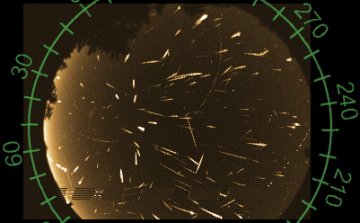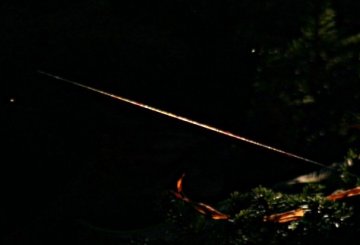 Where's Saturn? Is that a UFO--or the ISS? What's the name of that star? Get the answers from mySKY--a fun new astronomy helper from Meade. Where's Saturn? Is that a UFO--or the ISS? What's the name of that star? Get the answers from mySKY--a fun new astronomy helper from Meade. SOLAR CONJUNCTION: This week, three planets are gathering around sun: Mercury, Saturn and Venus. Bright sunlight hides the event from human eyes, but SOHO's coronagraph, which blocks the glare, has a great view: today's image. Mercury and Saturn are already "in conjunction"; Venus will join them on Aug. 16th. POST-PERSEIDS: The Perseid meteor shower is subsiding. According to the International Meteor Organization, the display peaked sharply late on August 12th. The maximum rate was near 100 meteors per hour: data. Amateur astronomer Chris Peterson recorded this Perseid summary using an all-sky camera in Guffey, Colorado: 
"This is a composite image spanning four evenings, August 10th through 13th. It shows 284 meteors, nearly all Perseids," says Peterson. 2007 Perseid Meteor Gallery
Updated Aug. 14, 2007 ARACHNID METEOR SHOWER: This past weekend in San Francisco, Mila Zinkova photographed a very strange meteor cutting through the branches of a tree. It was not a Perseid; it was an Arachnid: 
"It's a spider's web," says Zinkova: click here. Sunlight glinting through the silken strand created a pseudo-meteor in the shadows of the tree. "It's been so foggy here in San Francisco lately, this may be the only meteor I see this month!" Readers, whenever you see a spider web in sunlight, pause to look. Arachnid meteors are just one of the many things you might see.
.2007 Noctilucent Cloud Gallery
[Night-Sky Cameras] ["Noctilucent Cloud"--the song] | 
